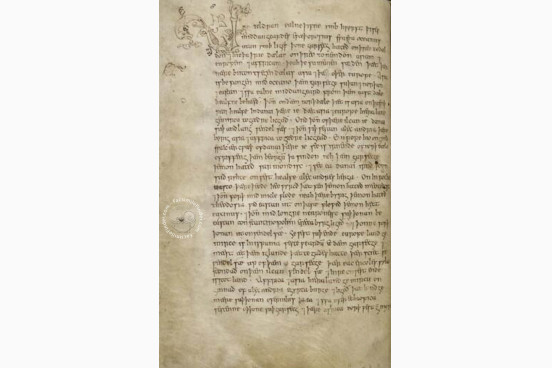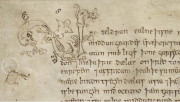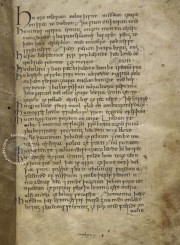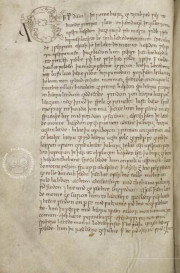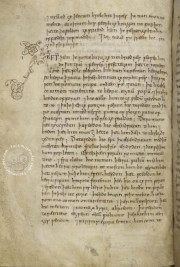This English language copy of Paulus Orosius’s Historiae Adversus Paganos was produced in Winchester, England between 870 and 930. It is also known as the Lauderdale Orosius and the Tollemache Manuscript after its former seventeenth-century owners. The manuscript was written by a single scribe in a square Insular minuscule. Five of the six chapters begin with an enlarged zoomorphic initial in pen-and-ink outline. The missing second quire, fols. 4-16, was replaced in the seventeenth century. Various other marginal additions including runic alphabets appear throughout the manuscript.
Aside from the zoomorphic initials, there is no further decorative program in the Old English Orosius, however, the initial folio is replete with various pictorial additions. The main drawing is a kneeling figure of the evangelist Matthew, who holds aloft an orb. Above him are symbolic depictions of the other three evangelists. Between these is a rectangular field filled with symmetric curling vines, the foliage enhanced with red. On the reverse is a rather less skilled copy of the kneeling Matthew image. Given its place as the earliest known English language translation of this popular text, it is an important manuscript in Early English studies.
Earliest Known English Language Orosius
The text, Historiae Adversus Paganos by Paulus Orosius, was written in early fifth century Spain after his travels throughout the Mediterranean. He is a contemporary of and had contact with Augustus of Hippo and Jerome of Stridon.
His work is both history and geography and was a popular text throughout the Middle Ages with over 250 extant manuscript copies. This copy is the earliest known in the English language. The translation is traditionally attributed to King Alfred, however modern research prefers an anonymous translator. Its dialect of Old English is the prototypical West Saxon.
Work of the Winchester Scriptorium
The Old English Orosius is the product of the important scriptorium at Winchester. The scribe’s hand appears in parts of the A-text of the Anglo-Saxon Chronicle (Cambridge, Corpus Christi College, MS 173, ff. 16v-25v) and the five large zoomorphic initials (fols. 5v, 21r, 31v, 48v and 65v) compare favorably to the Junius Psalter (Oxford, Bodleian Library, MS Junius 27) and the Tanner Bede (Oxford, Bodleian MS Tanner 10), both products of Winchester.
Centuries of Additions and Repairs
The manuscript’s ownership is unknown before the seventeenth century. The first record of it dates to the 1670s when it entered the library of John Maitland, Duke of Lauderdale. It may have been owned by the mathematician John Dee prior to this, but no record of this ownership exists.
The missing second quire (fols. 4-16) was replaced by Thomas Marshall from Junius's transcript of British Library Cotton Tiberius B I translation of Orosius in a seventeenth-century version of the original Insular minuscule.
During this time the Exchequer Roll fragments from 1346 were bound in. The book passed into the ownership of Lionel Tollemache, Earl of Dysart, and remained in that family until it was purchased by the British Museum in 1953.
The binding is a rare survival from the fifteenth century. The medieval boards are covered with white deerskin leather. The pigskin spine is a later repair. Working metal clasps on modern leather straps are inscribed “IHC” and “M”.
We have 1 facsimile edition of the manuscript "Old English Orosius": The Tollemache Orosius facsimile edition, published by Rosenkilde and Bagger, 1953
Request Info / Price
